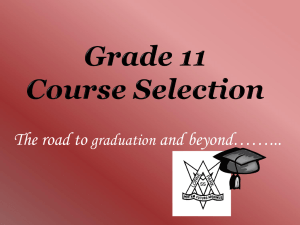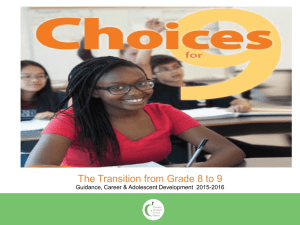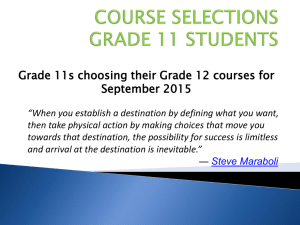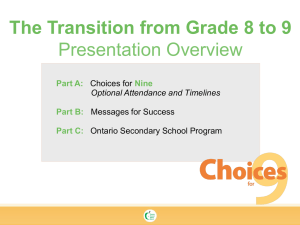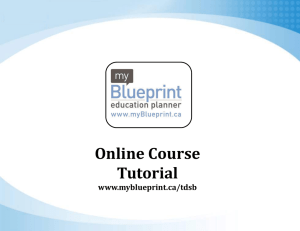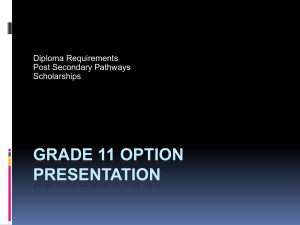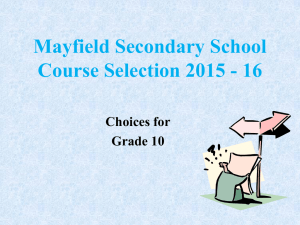Choices 2015–2016 - Toronto District School Board
advertisement
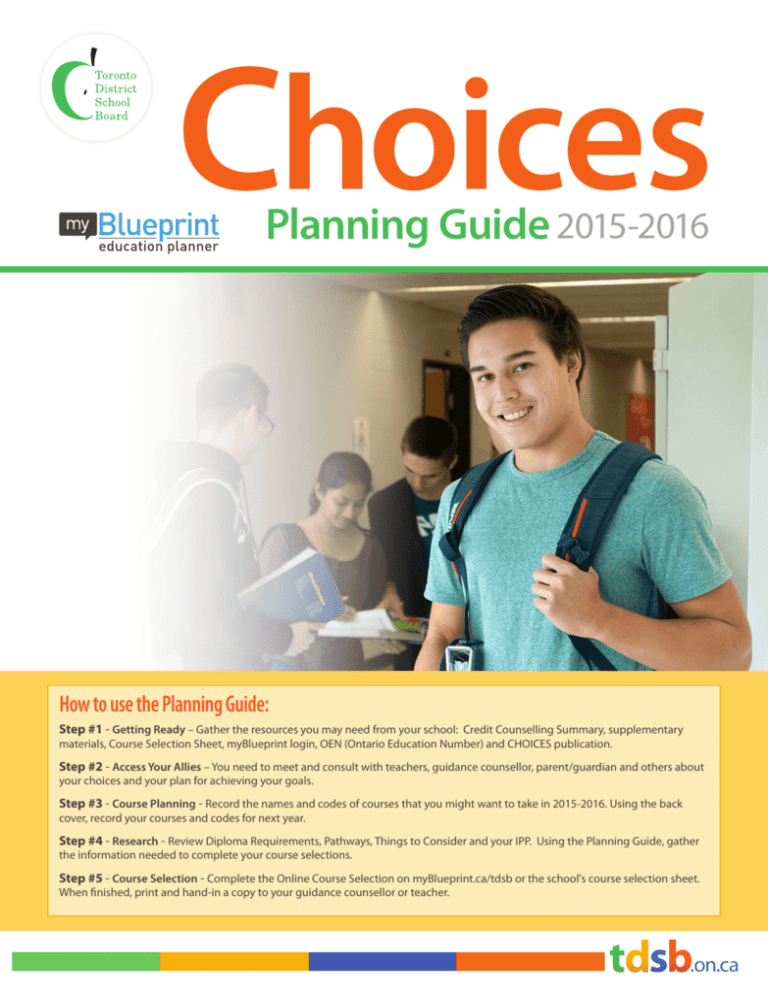
Choices Planning Guide 2015-2016 How to use the Planning Guide: Step #1 - Getting Ready – Gather the resources you may need from your school: Credit Counselling Summary, supplementary materials, Course Selection Sheet, myBlueprint login, OEN (Ontario Education Number) and CHOICES publication. Step #2 - Access Your Allies – You need to meet and consult with teachers, guidance counsellor, parent/guardian and others about your choices and your plan for achieving your goals. Step #3 - Course Planning - Record the names and codes of courses that you might want to take in 2015-2016. Using the back cover, record your courses and codes for next year. Step #4 - Research - Review Diploma Requirements, Pathways, Things to Consider and your IPP. Using the Planning Guide, gather the information needed to complete your course selections. Step #5 - Course Selection - Complete the Online Course Selection on myBlueprint.ca/tdsb or the school's course selection sheet. When finished, print and hand-in a copy to your guidance counsellor or teacher. .on.ca Diploma Requirements RESOURCES YOU MAY NEED: • Course Selection Sheet • Choices publication • www.tdsb.on.ca/Choices • Supplementary materials from your school • Credit Counselling Summary sheet • myBlueprint login • OEN (Ontario Education Number) • 30 Credits (18 compulsory) • Literacy requirement • 40 hours of Community involvement WHAT DO YOU NEED TO GRADUATE? Ontario Secondary School Diploma Requirements • Successful completion of literacy requirement • 40 hours of community involvement • 30 credits: (18 compulsory and 12 optional) 4 English, one per grade level 1 French as a second language 3 Mathematics, at least one in Grade 11 or 12 2 Science 1 Canadian geography 1 Canadian history 1 Arts (dance, drama, media, music, visual arts) 1 Health and physical education 0.5 Civics 0.5 Career studies Plus one credit from each of the following groups: Group 1: or or or or or or Recommended Courses GRADE 9 GRADE 10 • • • • • • • • English Mathematics Science Canadian Geography Health & Physical Education French Arts _________ • • • • • • • • English Mathematics Science Canadian History Civics/Career Studies ________ ________ ________ Group 2: a Business Studies credit or a credit in Health and Physical Education or a credit in the Arts or a credit in Cooperative Education * or French as a second language * COMMUNITY INVOLVEMENT Group 3: or or or or 40 HOURS – Get Started! Keep a record – Get Proof: an additional English credit French as a second language* a third language a Social Sciences and Humanities credit a Canadian and World Studies credit a Guidance and Career Education credit a Cooperative Education credit * • dates • hours • organization/contact a Grade 11 or 12 Science credit a Technological Education credit a Computer Studies credit a Cooperative Education credit * French as a second language * plus 12 optional credits * A maximum of two credits in Cooperative Education and two credits in French can count as compulsory credits. Learning to 18 Students must attend school until age 18 or graduation. B Choices 2015–2016 LITERACY REQUIREMENT Students must write the Ontario Secondary School Literacy Test (OSSLT), which is created and marked by EQAO. Students who write the OSSLT and who have been unsuccessful at least once are eligible to take the Ontario Secondary School Literacy Course (OLC4O). COMMUNITY INVOLVEMENT Students must complete a minimum of 40 hours of community involvement prior to graduation. • An indication of completion will be entered on the student’s Ontario Student Transcript when the 40 hours have been submitted. • The selection and management of the involvement is to be directed by the student and approved by the secondary school. • Activities may take place inside or outside the school. If inside, activities may not be part of a credit program. • The student may not displace a worker who would normally have been paid to perform the same function. • Community involvement may begin in the summer after Grade 8. • For more information, go to Choices 2015 on page 37. For volunteer opportunities check: www.volunteertoronto.ca Begin with an End in Mind Where are you going first after secondary school? PLAN AHEAD ACCESS YOUR ALLIES • What courses will you need to graduate? • What courses will you need to get into a postsecondary program, e.g. training program or college or university? • Visit the Guidance Office • Talk to your... - parents/guardians - teachers - guidance counsellor - friends GOING TO WORK? Check out: What is your destination? APPRENTICESHIP q COLLEGE q UNIVERSITY q WORK q GOING TO APPRENTICESHIP? • Learn a skilled trade by combining courses with paid on-the-job training • Check out Co-op as an OYAP Opportunity • TDSB Job Fair – Work Connections • Community Employment Centres • myBlueprint.ca > Resume & Cover Letter > JOB FINDER GOING TO COLLEGE? GOING TO UNIVERSITY? What marks do they use for early admission? • Gr. 11 & 1st semester Grade 12 • Average in College courses 70%+ • University & Mixed courses 60%+ • What marks do they use for early admission? 4U or 4M Finals from first semester and Mid-Terms from second semester • Cut-offs www.electronicinfo.ca ONtransfer.ca - A website to help you plan post-secondary education, whether you want to go straight to your educational goal or make some stops along the way. Also, looks at transfers between college and university programs. Is OYAP for you? Cooperative Education • • • • • • • • • Enjoy learning by doing? Earn while you learn Make future connections Become a skilled professional See a counsellor or co-op teacher Links academics with work experience Usually a separate application Interview is required Interested? See your guidance counsellor. OYAP Ontario Youth Apprenticeship Program • Enables students in Grade 11 or 12 to complete OSSD requirements while starting their apprenticeship training in one of the skilled trades Examples: Early Childhood Education, Carpentry, Automotive, Culinary Arts, Plumbing. www.oyaptdsb.com Internet research sites • • • • • • www.apprenticesearch.com www.electronicinfo.ca www.ontariocolleges.ca www.ouac.on.ca www.careercruising.com Apprenticeship: www.tcu.gov. on.ca/eng/employmentontario/ training • myBlueprint.ca/tdsb NEED TO SEE A COUNSELLOR? Counsellors are available to assist you. Make an appointment or follow the protocol that your school uses during course selection time. Toronto District School Board C Things to Consider SEMESTERED AND FULL-YEAR SCHOOLS DID YOU KNOW? • Secondary schools are generally organized on either a full-year model (non-semestered) or a half-year model (semestered). • There are many pathways to the same destination and sometimes it is more beneficial to build self-esteem, confidence and a sense of hope by being successful first and foremost. • Students in a full-year, non-semestered secondary school usually study eight courses from September to June. The year is divided into two or three terms for examination and reporting purposes. • Students in a half-year semestered secondary school usually study four courses from September to January, and four courses from February to June, with examinations and reports at the end of each semester. •Students who select courses that are consistent with their interests, most recent achievement, strengths, needs or preferred learning style(s) create a foundation for success. • There are many opportunities to build on success and change pathways at many points on your secondary path. • If you are interested in changing your pathway to a new destination, see your guidance counsellor. FIND YOUR DESTINATION COURSES Grade 9/10 Grade 11/12 COLLEGE (C) APPLIED (P) ACADEMIC (D) UNIVERSITY/COLLEGE (M) LDCC (L) UNIVERSITY (U) OPEN (O) WORKPLACE (E) K-COURSES (N) OPEN (O) Locally Developed Compulsory 5-YEAR PLAN OPTION • Is it part of your plan to take five years in secondary school? • Do you want to do co-op, apprenticeship training (OYAP) and explore more options? Although courses are organized into four grade categories, some students may take longer than four years to complete their diploma without repercussions to their future plans. For students who have an IEP or have credits in ESL or want to explore cooperative or technological education, OYAP, etc, a five-year option may be another planning option. Alternative Non-Credit SPECIAL NEEDS STUDENTS Students who have had an IPRC have the opportunity to take Learning Strategies courses (GLE) in secondary schools in the TDSB. Students requiring a more individualized program or self-contained classes need to consult the Special Education teacher in your school to access additional supports your school may offer. FULL DISCLOSURE MATHEMATICS TRANSFER COURSE • Required to change from Math Grade 9 Applied to Grade 10 Academic • Credit value is 0.5 (half credit) • Available through Continuing Education at summer school D Choices 2015–2016 • All Grades 11 and 12 final course marks, withdrawals and repeats are recorded on transcripts. • WITHDRAWAL – Dropped course after second to last report card. • REPEAT course(s) – both mark attempts are shown, but only one credit issued for highest mark. NO GUARANTEES • All course offerings are subject to availability. • Successful completion of a diploma does not guarantee admission to training programs or postsecondary institutions such as colleges and/or universities. Pathways These charts map out all the courses in the discipline and show the link between courses and the possible prerequisites for them. They do not attempt to depict all possible movements from course to course. PATHWAYS IN ENGLISH Indicates alternative pathway English ENG1D Grade 9, Academic English ENG2D Grade 10, Academic English ENG3U Grade 11, University English ENG4U Grade 12, University English ENG1P Grade 9, Applied English ENG2P Grade 10, Applied English ENG3C Grade 11, College English ENG4C Grade 12, College English Grade 9, LDCC English Grade 10, LDCC English ENG3E Grade 11, Workplace English ENG4E Grade 12, Workplace PATHWAYS IN MATHEMATICS Mathematics MAT1L Foundations of Math MFM1P Mathematics MAT2L Foundations of Math MFM2P Grade 9, LDCC Grade 10, LDCC Workplace Math for Everyday Life MEL3EGrade 11, Workplace Math for Everyday Life MEL4E Grade 12, Workplace T Grade 9, Applied Principles of Math MPM2D Grade 10, Academic Functions and Applications MCF3M Foundations for College Math MBF3C Math for College Technology MCT4C Grade 12, College PATHWAYS IN SCIENCE Science SNC1D Grade 9, Academic Science SNC2D Grade 10, Academic Science SNC2P Grade 10, Applied Science SNC2L Grade 10, LDCC MHF4U must be taken prior to or concurrently with MCV4U Advanced Functions MHF4U Math of Data Management MDM4U Grade 12, University Grade 12, University Biology SBI3U Grade 11, University Chemistry SCH3U Grade 11, University Physics SPH3U Grade 11, University Environmental Science SVN3M Grade 11, University/College Biology SBI3C Grade 11, College Science SNC1L Grade 9, LDCC Note: Grade 11, University Any Grade 11 university, university/college, or college preparation course in science. Science SNC1P Grade 9, Applied indicates alternative pathway Functions MCR3U Grade 11, University/ College Preparation Grade 11, College Grade 12, College MPM1HT Transfer Course required from MFM 1P to MPM 2D Credit value: 0.5 Grade 9, Academic Grade 10, Applied Foundations for College Math MAP4C T Principles of Math MPM1D Environmental Science SVN3E Grade 11, Workplace Calculus and Vectors MCV4U Grade 12, University Earth & Space Science SES4U Grade 12, University Biology SBI4U Grade 12, University Chemistry SCH4U Grade 12, University Physics SPH4U Grade 12, University Science SNC4M Grade 12, University/College Chemistry SCH4C Grade 12, College Physics SPH4C Grade 12, College Science SNC4E Grade 12, Workplace Toronto District School Board E Completing Your Online Course Selection 1) Get Started In your browser go to www.myBlueprint.ca/tdsb. 2) Existing User? Enter your email and password. Need An Account? In the New Users box on the left of the page, select your Secondary School from the dropdown and click “Create Account”. As a New User, you will require the following information before you begin: • Valid email address • Ontario Education Number (OEN) found on timetable Required once only • Your date of birth (DOB) Required once only 3) Your Official High School Plan Once you have completed the registration process, you can access your "Official High School Plan" by clicking on the "Submit Courses" button in the Course Selection box on the home page. Course Selection Enabled Submit Courses If the Course Selection box says “Plan Courses” you can plan your courses but you cannot submit them until your school has enabled course selection. F Choices 2015–2016 If you do not see the Course Selection box, check the Course Selection issue alert at the top left of your home page. Red box indicates issue with course. If a prerequisite is missing, fill it in. Your marks are indicated for all completed courses. Completing Your Online Course Selection 4) Add Your Courses for Next Year • In the High School Planner grid, click “Add [Course]”. • Add compulsories first, and if required use the first four spaces for Semester I prerequistes for Semester II courses. • In the Course Selection and Details screen, explore the courses available to you. • Click “Add Course to Plan” when you find the course you want. It is automatically saved. ! ATTENTION CHOOSE WISELY! • Think of your plan • Think of your future Course Type C = College D = Academic E = Workplace L = Locally Developed Compulsory M =College or University O = Open P = Applied U = University N = Non-Credit 5) Look at Your Graduation Progress The sixth position indicates program or credit differentiation, or the focus of the course. In this case: 1 = Regular Course Code’s fifth position indicates the course type. The Graduation Indicator will help you keep track of your progress. Click “View Progress” for a list of specific Ontario Secondary School Diploma requirements. Review this feature to ensure you are selecting courses that will keep you on track to graduate! Program Differentiation for Non-Tech Courses 1 = Regular credit course 2 = Beginner or Introductory course 3 = Enriched course 4 = Extended French course 5 = French Immersion course 6 = Gifted course 7 = International Baccalaureate course 8 = Self-contained ESL course 9 = Self-contained special education course 0 = Advanced Placement A = Part 1 (0.5) B = Part 2 (0.5) E = e-Learning course Health and Physical Education F = course for females M = course for males 1 = co-ed courses French Immersion and other specialty programs have a unique sixth character indicated on individual school chart. Program Differentiation for Tech Courses Tech credits sixth character indicate credit value: 1, 2 or 3 credits e.g. TTJ3C2 = 2 credits. 6) What can You do after High School? Before you submit your courses, it is important to understand the impact they will have on your future after secondary school. Plan ahead and build a full 30-credit plan to instantly discover the post-secondary opportunities available to you using the Pathway Eligibility Indicator. Toronto District School Board G Completing Your Online Course Selection 8) Review and Confirm 7) Submit Your Courses You can only submit once! When you are ready to submit your course selections, click “Submit (Step 1 of 2)”. Note: the “Submit” button will only appear if it is course selection time (as set by your school). Carefully review the Submission Details page to ensure that you are meeting the requirements for the courses you have selected and that the courses that appear are correct. Once you have reviewed, click “Submit (Step 2 of 2)”. 9)Print! Click on print Sign-Off Sheet and return a signed copy of your course selection sheet to your counsellor or teacher. Note Review Details for any issues before submitting. My online submission must be completed by: E D U C AT I O N / C A R E E R PL A N N E R Planning Ahead Fill in the courses you have taken, are presently taking and plan to take on the chart. What compulsories do you need? H Choices 2015–2016 Grade 9 Grade 10 Grade 11 Grade 12 English English English English Math Math Math Science Science Geography History Phys. & Health Education Civics/Careers French Electives (G1, G2, G3) Arts Electives (G1, G2, G3) Electives (G1, G2, G3) Electives (G1, G2, G3) 5th Year myBlueprint’s privacy policy is located at www.myBlueprint.ca/privacy-policy
